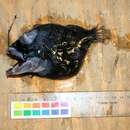en
names in breadcrumbs


View data on Catalog of Fishes here.
Escal appendage pattern B; esca with a stout, internally pigmented anterior appendage not longer than escal bulb, bearing distally a large compressed papilla at the anterior base of which usually arise two or three short filaments; posterior margin of anterior appendage bearing one to five (usually three) stout papillae; filaments and papillae of anterior appendage darkly pigmented in most specimens larger than approximately 50 mm; a pair of minute filamentous medial escal appendages in most specimens smaller than approximately 110 mm, unpigmented in most specimens smaller than approximately 80 mm, darkly pigmented in most specimens 80–110 mm; each medial appendage represented by a pair of minute dark spots of pigment in most specimens larger than approximately 110 mm; a truncated terminal escal papilla with a distal streak of pigment; a posterior escal appendage, shorter than length of anterior appendage, bearing three to six short filaments or papillae, darkly pigmented in some specimens 115 mm and larger; lateral escal appendages absent; a minute unpigmented filamentous anterolateral escal appendage in most specimens less than approximately 60 mm.
Subopercle without indentation on posterodorsal margin; length of ventral fork of opercle 24.8–32.7% SL; ratio of lengths of dorsal and ventral forks of opercle 0.53–0.71.
Epibranchial teeth absent; teeth present on pharyngobranchial II; total number of teeth in upper jaw 20–55, in lower jaw 24–51; number of teeth on vomer 4–8; dorsal-fin rays 5–7; anal-fin rays 4; pectoral-fin rays 15–18.Measurements in percent of standard length: head length 34.2–44.5; head depth 35.2–53.6; premaxillary length 27.3–33.9; lower jaw length 38.6–51.8; illicium length 18.6–28.6.
The relatively large amount of material of O. acanthias, including a wide size range of individuals (147 specimens, 11.5–167 mm), provides a good understanding of the intraspecific variation and ontogenetic change that occurs within a member of the genus Oneirodes. Head length and depth, illicium and lower jaw length, and the number of lower-jaw teeth all decrease slightly with growth. This large series has had its greatest value in elucidating ontogenetic changes that occur in the morphology of the esca, by far the most important taxonomic character complex of the genus. These changes are outlined in the description of the esca of O. acanthias above.
A species of Oneirodes differing from all other members of the genus in escal morphology. In this character complex it is most similar to O. thompsoni and O. notius. However, the posterior escal appendage, always branched in O. acanthias, is never branched in O. thompsoni and O. notius. Although the slightly higher tooth counts of O. acanthias and greater ratio between the lengths of the dorsal and ventral forks of the opercle (0.53–0.71 and 0.42–0.54 for O. acanthias and O. thompsoni, respectively) further help to distinguish this species from O. thompsoni, the characters of the esca are the only satisfactory means of separating O. acanthias from this and from most other species of the genus.
Oneirodes acanthias is known only from the Eastern North Pacific Ocean as far west as 126°37.5'W, between 37°48'N and 26°51'N.
Meso- to bathypelagic.
Pietsch TW. 2009. Oceanic Anglerfishes: Extraordinary Diversity in the Deep Sea. Berkley: University of California Press. 638 p.
As with most oneirodid taxa, males of the genus Oneirodes are free-living and presumed non-parasitic.
Oneirodes acanthias approaches sexual maturity at a length of approximately 100 mm. The ovaries of a 125-mm specimen (LACM 9664-18) are about 41 mm long (30.5% SL) and contain approximately 100,000 eggs of a single size class, measuring 0.5–0.7 mm in diameter.
Known from 153 metamorphosed females (11.5–167 mm).
ALBATROSS station 4428, off Santa Cruz Island, Point Loma Light, southern California, 0–1629 m, 4 March 1904.
Holotype of Oneirodes acanthias: USNM 75825, 33 mm.